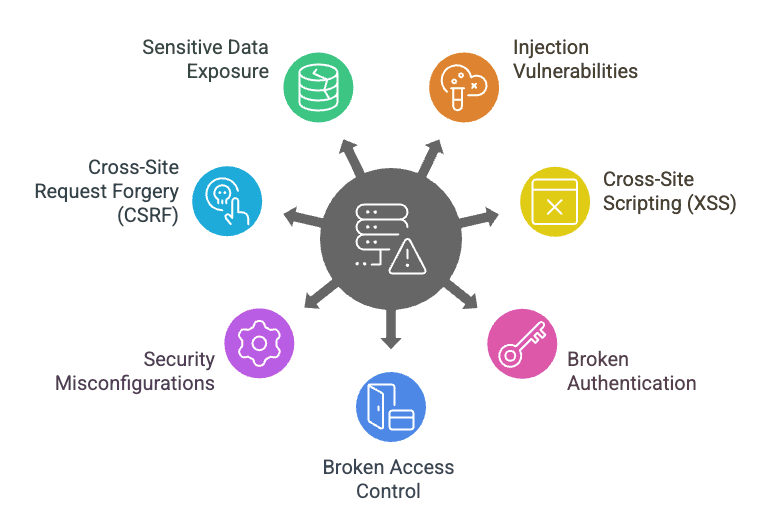Web Application Vulnerabilities: What Every Developer Should Know in 2025
As applications become increasingly complex and interconnected, the security vulnerabilities they face continue to evolve. For developers, understanding these vulnerabilities is no longer optional—it's a fundamental aspect of professional software development and a core component of web application security. While you might not be a security specialist, having a working knowledge of common web application vulnerabilities can significantly improve the quality and security of your code.
This guide focuses on the vulnerabilities you're most likely to encounter in everyday development work and provides practical approaches to addressing them—without requiring you to become a security expert.
The Most Common Web Application Vulnerabilities

1. Injection Vulnerabilities
Injection vulnerabilities continue to dominate the threat landscape despite being well-documented for decades. These flaws occur when applications fail to properly validate, filter, or sanitize user-supplied data before using it in interpreters like SQL engines, NoSQL databases, operating system commands, XML processors, or ORM tools. Attackers exploit these vulnerabilities by sending crafted input that tricks the interpreter into executing unintended commands or accessing unauthorized data. The impact can be severe, ranging from data theft and manipulation to complete system compromise. What makes injection vulnerabilities particularly dangerous is that they often provide attackers with elevated privileges within application environments, giving them capabilities far beyond those of normal users.
- SQL Injection: Still common despite being well-understood, SQL injection happens when user-supplied data is included in database queries without proper sanitization. Modern frameworks include protections, but developers who build custom queries remain at risk.
- NoSQL Injection: Similar to SQL injection but targeting NoSQL databases like MongoDB, these attacks manipulate query logic to access unauthorized data.
- Command Injection: Occurs when applications pass unsafe user data to system shell commands, allowing attackers to execute arbitrary commands on the host system.
Use parameterized queries, ORMs (Object-Relational Mappers), and input validation. Never directly incorporate user input into commands or queries.
2. Cross-Site Scripting (XSS)
Cross-Site Scripting vulnerabilities represent one of the most pervasive web security flaws, affecting applications across all industries and technology stacks. These vulnerabilities arise when applications incorporate untrusted data into a web page without proper validation or encoding, allowing attackers to inject client-side scripts that execute in users' browsers. What makes XSS particularly insidious is that the injected scripts run with the privileges of the victim user, giving attackers the ability to access cookies, session tokens, or sensitive information displayed on screen. In modern single-page applications, DOM-based XSS has become increasingly prevalent as more logic moves to the client side, creating new attack surfaces that traditional server-side protections don't address. The business impact of XSS can range from minor user experience disruption to complete account compromise.
- Reflected XSS: User input is immediately returned to the browser without proper encoding.
- Stored XSS: Malicious script is saved on the server (in a database, comment section, etc.) and runs when other users access that content.
- DOM-based XSS: Occurs when JavaScript modifies the DOM in an unsafe way based on user input.
Always encode output data before displaying it to users. Use Content Security Policy (CSP) headers. Leverage modern frameworks that automatically escape content.
3. Broken Authentication
Authentication vulnerabilities represent critical security flaws that can compromise the entire security model of an application. These vulnerabilities occur when applications implement authentication and session management functions incorrectly, allowing attackers to compromise passwords, session tokens, or keys and assume users' identities. The consequences of broken authentication can be particularly severe, as attackers often target privileged accounts to gain administrative access to systems. In 2025's landscape of complex, interconnected applications, authentication vulnerabilities have become more sophisticated, with attackers leveraging techniques like credential stuffing (using automated tools to try previously stolen username/password combinations) and session hijacking through various means. As more organizations implement single sign-on and federated authentication, misconfiguration of these complex systems has created new attack vectors.
Common issues include:
- Weak password policies
- Improper session management
- Insecure credential storage
- Susceptibility to brute force attacks
- Missing multi-factor authentication
Implement strong authentication controls, secure session management, and appropriate account lockout mechanisms. Use established authentication frameworks rather than building your own.
4. Broken Access Control
Access control vulnerabilities represent some of the most commonly exploited flaws in web applications, primarily because access control design is complex and often implemented inconsistently across application components. These vulnerabilities occur when applications fail to properly enforce restrictions on what authenticated users are allowed to do, allowing attackers to access functionality or data they shouldn't have permission to see. The fundamental problem lies in transitioning from "who you are" (authentication) to "what you're allowed to do" (authorization) in a secure, consistent manner. Modern microservices architectures have complicated access control further, as authorization decisions may be distributed across multiple services with different security models. When exploited, these vulnerabilities can lead to unauthorized information disclosure, data modification, or performing unauthorized functions.
Examples include:
- Modifying URLs to access admin functions
- Viewing other users' accounts by changing IDs
- Bypassing permission checks
- API endpoints without proper authorization
Implement proper authorization checks at the server level for all resources and functions. Never rely on hiding elements in the user interface as a security control.
5. Security Misconfigurations
Security misconfigurations have emerged as the most commonly seen vulnerability in modern applications, largely due to the increasing complexity of technology stacks and deployment environments. Unlike code-level vulnerabilities, misconfigurations often arise from improper setup, incomplete default settings, open cloud storage, verbose error messages, or outdated software components. The challenge for developers has multiplied as applications now typically involve multiple components, from front-end frameworks and APIs to containers and orchestration systems—each with their own configuration requirements and security implications. Misconfiguration vulnerabilities are particularly dangerous because they often expose systems directly without requiring sophisticated exploitation techniques; attackers simply find and use functionality or access that shouldn't be available to them. In cloud environments especially, misconfigurations like overly permissive access controls or exposed management interfaces have led to numerous major data breaches.
Common misconfigurations include:
- Unnecessary features enabled or installed
- Default accounts with unchanged passwords
- Error handling that reveals too much information
- Outdated software or components
- Unprotected cloud storage
Establish secure configuration processes, perform regular audits, and maintain minimal platforms with only necessary features. Use automated scanning tools to detect misconfigurations.
6. Cross-Site Request Forgery (CSRF)
Cross-Site Request Forgery vulnerabilities represent a sophisticated attack vector that exploits how web browsers handle authentication. CSRF attacks work by tricking users who are authenticated to a targeted site into submitting requests to that site without their knowledge or intention. These attacks leverage the fact that browsers automatically include authentication credentials (like session cookies) with requests to sites where users have active sessions. The real danger of CSRF lies in its stealthy nature—victims typically have no idea malicious actions have been performed on their behalf, which might include funds transfers, password changes, or data modifications. While many modern frameworks have built-in CSRF protections, custom implementations and legacy applications often remain vulnerable, especially as web applications become more complex and feature-rich.
Implement anti-CSRF tokens, use SameSite cookie attribute, and verify the origin of requests. Most modern frameworks include CSRF protection that you should enable.
7. Sensitive Data Exposure
Sensitive data exposure vulnerabilities occur when applications fail to adequately protect critical information such as financial data, healthcare records, personally identifiable information (PII), or authentication credentials. These vulnerabilities differ from many others because they often don't involve direct attacks on application code, but rather exploit insufficient protection mechanisms for sensitive data both at rest and in transit. In today's environment, where data privacy regulations like GDPR, CCPA, and industry-specific requirements impose strict controls on how sensitive information is handled, these vulnerabilities carry both security and compliance implications. The risk has intensified as applications collect and process more personal data than ever before, often distributing it across multiple services, data stores, and third-party integrations. When sensitive data is exposed, the consequences can include identity theft, financial fraud, privacy violations, and significant regulatory penalties.
Common issues include:
- Transmitting data in cleartext
- Weak encryption
- Improper certificate validation
- Storage of sensitive data in logs or backups
Identify sensitive data and encrypt it both at rest and in transit. Use strong algorithms and proper key management. Don't store sensitive data unnecessarily.
Vulnerability Detection and Testing
Regular Security Testing
Incorporate these security testing approaches into your development workflow:
- Static Application Security Testing (SAST): Analyzes source code for security issues without executing the application. Integrate SAST tools into your IDE or CI/CD pipeline to catch vulnerabilities early.
- Dynamic Application Security Testing (DAST): Tests running applications to find vulnerabilities that might only appear during execution. Run DAST tools against staging environments before production deployment.
- Security Code Reviews: Have team members review code specifically for security issues, not just functionality or style.
Vulnerability Scanning Tools
Several tools can help developers identify vulnerabilities with minimal effort:
- IDE plugins: Security-focused extensions like Snyk for VS Code, SonarLint, and GitGuardian help identify vulnerabilities while writing code
- Dependency scanners: Tools such as OWASP Dependency-Check, Snyk, and GitHub's Dependabot automatically scan your dependencies for known vulnerabilities
- Web application scanners: OWASP ZAP (Zed Attack Proxy), Burp Suite Community Edition, and Acunetix provide automated vulnerability detection for deployed applications
- Cloud configuration scanners: Tools like Prowler (for AWS), Azure Security Center, and Trivy can identify misconfigurations in cloud environments
- API security testing tools: Postman, APIsec, and 42Crunch can help identify vulnerabilities specific to API endpoints
Many of these tools now include AI assistance to reduce false positives and provide clearer remediation guidance.
Building a Security Mindset
Developing a security mindset is as important as knowing specific vulnerabilities:
- Think Like an Attacker: Consider how your application could be misused or abused, not just how it should function normally.
- Defense in Depth: Don't rely on a single security control. Implement multiple layers of defense so that if one fails, others will protect your application.
- Least Privilege Principle: Users and components should have only the minimum privileges necessary to function.
- Secure by Default: Application features and components should be secure out of the box, without requiring additional configuration.
Conclusion
Understanding web application vulnerabilities is a crucial skill for all developers, not just security specialists. By familiarizing yourself with these common vulnerabilities and implementing the suggested prevention strategies, you can significantly improve the security posture of your applications and protect your users' data.
Remember that security is an ongoing process that requires continuous learning and adaptation as new threats emerge. Make security testing and review a regular part of your development lifecycle, not just a final step before deployment.
For developers looking to strengthen their application security beyond these basics, consider implementing advanced protection layers like those offered by EdgeOne. These solutions provide additional safeguards against sophisticated attacks targeting web applications, including DDoS protection and web protection capabilities that can detect and block exploitation attempts before they reach your code.
Ready to see how a comprehensive security solution can complement your secure coding practices? Start your free trial today and experience enterprise-grade protection that works alongside your application-level security measures.

